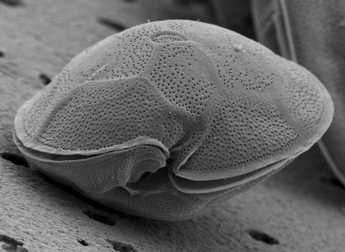Ciguatera: Difference between revisions
| Line 4: | Line 4: | ||
==Disease Pathology== | ==Disease Pathology== | ||
The ciguatera toxin is found in large reef fish, most often the barracuda, grouper, red snapper, eel, amberjack, sea bass, and Spanish mackerel.<ref name=’Medicine’>Cunha, John P. "Ciguatera Poisoning: Read About Facts and Tests."MedicineNet. Ed. Melissa C. Stöpper. MedicineNet, 2 Sept. 2014. </ref> When large predator fish, such as the barracuda eat smaller fish that consume toxin-producing algae, such as dinoflagellates, the toxin accumulates in the bigger fish.<ref name =’Medicine’></ref> | The ciguatera toxin is found in large reef fish, most often the barracuda, grouper, red snapper, eel, amberjack, sea bass, and Spanish mackerel.<ref name=’Medicine’>Cunha, John P. "Ciguatera Poisoning: Read About Facts and Tests."MedicineNet. Ed. Melissa C. Stöpper. MedicineNet, 2 Sept. 2014. </ref> When large predator fish, such as the barracuda eat smaller fish that consume toxin-producing algae, such as dinoflagellates, the toxin accumulates in the bigger fish.<ref name =’Medicine’></ref> | ||
While the Ciguatera toxin is harmless to fish, it is poisonous to humans.<ref name=’Charles’>Davis, Charles P. "Ciguatera Fish Poisoning: Get Facts on Ciguatera Toxin."EMedicineHealth. Ed. Jerry R. Baletine. EMedicineHealth, 26 Mar. 2015</ref> The toxin is difficult to detect, as it is odorless and tasteless and cannot be destroyed by cooking.<ref name=’Charles’></ref> This is particularly relevant as the primary way humans are exposed to the toxin is eating ciguatera-contaminated tropical or subtropical fish. | While the Ciguatera toxin is harmless to fish, it is poisonous to humans.<ref name=’Charles’> Davis, Charles P. "Ciguatera Fish Poisoning: Get Facts on Ciguatera Toxin."EMedicineHealth. Ed. Jerry R. Baletine. EMedicineHealth, 26 Mar. 2015</ref> The toxin is difficult to detect, as it is odorless and tasteless and cannot be destroyed by cooking.<ref name=’Charles’></ref> This is particularly relevant as the primary way humans are exposed to the toxin is eating ciguatera-contaminated tropical or subtropical fish. | ||
Once ingested, the toxin activates voltage-dependent sodium channels causing symptoms in human gastrointestinal, cardiac, and nerve tissues. | Once ingested, the toxin activates voltage-dependent sodium channels causing symptoms in human gastrointestinal, cardiac, and nerve tissues. | ||
==Symptoms== | ==Symptoms== | ||
==Treatment and Prevention== | ==Treatment and Prevention== | ||
==Notes== | ==Notes== | ||
<references /> | <references /> | ||
Revision as of 22:55, 1 March 2016
Ciguatera
 Ciguatera is the most frequently reported seafood-toxin illness in the world. [1] It is a food borne illness caused by eating fish containing toxins produced by dinoflagellate, a form of micro-algae, Gambierdiscus toxicus. [2] The most common symptoms of ciguatera poisoning include nausea, vomiting, diarrhea, muscle pain, dizziness, and vertigo[2]. While there is no cure for Ciguatera, there are multiple treatments available.[1] This disease has an annual reporting rate of roughly 50,000.[3]
Ciguatera is the most frequently reported seafood-toxin illness in the world. [1] It is a food borne illness caused by eating fish containing toxins produced by dinoflagellate, a form of micro-algae, Gambierdiscus toxicus. [2] The most common symptoms of ciguatera poisoning include nausea, vomiting, diarrhea, muscle pain, dizziness, and vertigo[2]. While there is no cure for Ciguatera, there are multiple treatments available.[1] This disease has an annual reporting rate of roughly 50,000.[3]
Disease Pathology
The ciguatera toxin is found in large reef fish, most often the barracuda, grouper, red snapper, eel, amberjack, sea bass, and Spanish mackerel.[4] When large predator fish, such as the barracuda eat smaller fish that consume toxin-producing algae, such as dinoflagellates, the toxin accumulates in the bigger fish.[4] While the Ciguatera toxin is harmless to fish, it is poisonous to humans.[3] The toxin is difficult to detect, as it is odorless and tasteless and cannot be destroyed by cooking.[3] This is particularly relevant as the primary way humans are exposed to the toxin is eating ciguatera-contaminated tropical or subtropical fish. Once ingested, the toxin activates voltage-dependent sodium channels causing symptoms in human gastrointestinal, cardiac, and nerve tissues.
Symptoms
Treatment and Prevention
Notes
- ↑ 1.0 1.1 Friedman, Melissa A. et al. “Ciguatera Fish Poisoning: Treatment, Prevention and Management.” Marine Drugs 6.3 (2008): 456–479. PMC.
- ↑ 2.0 2.1 "Ciguatera." Centers for Disease Control and Prevention. Centers for Disease Control and Prevention.
- ↑ 3.0 3.1 3.2 Davis, Charles P. "Ciguatera Fish Poisoning: Get Facts on Ciguatera Toxin."EMedicineHealth. Ed. Jerry R. Baletine. EMedicineHealth, 26 Mar. 2015 Cite error: Invalid
<ref>tag; name "’Charles’" defined multiple times with different content - ↑ 4.0 4.1 Cunha, John P. "Ciguatera Poisoning: Read About Facts and Tests."MedicineNet. Ed. Melissa C. Stöpper. MedicineNet, 2 Sept. 2014.